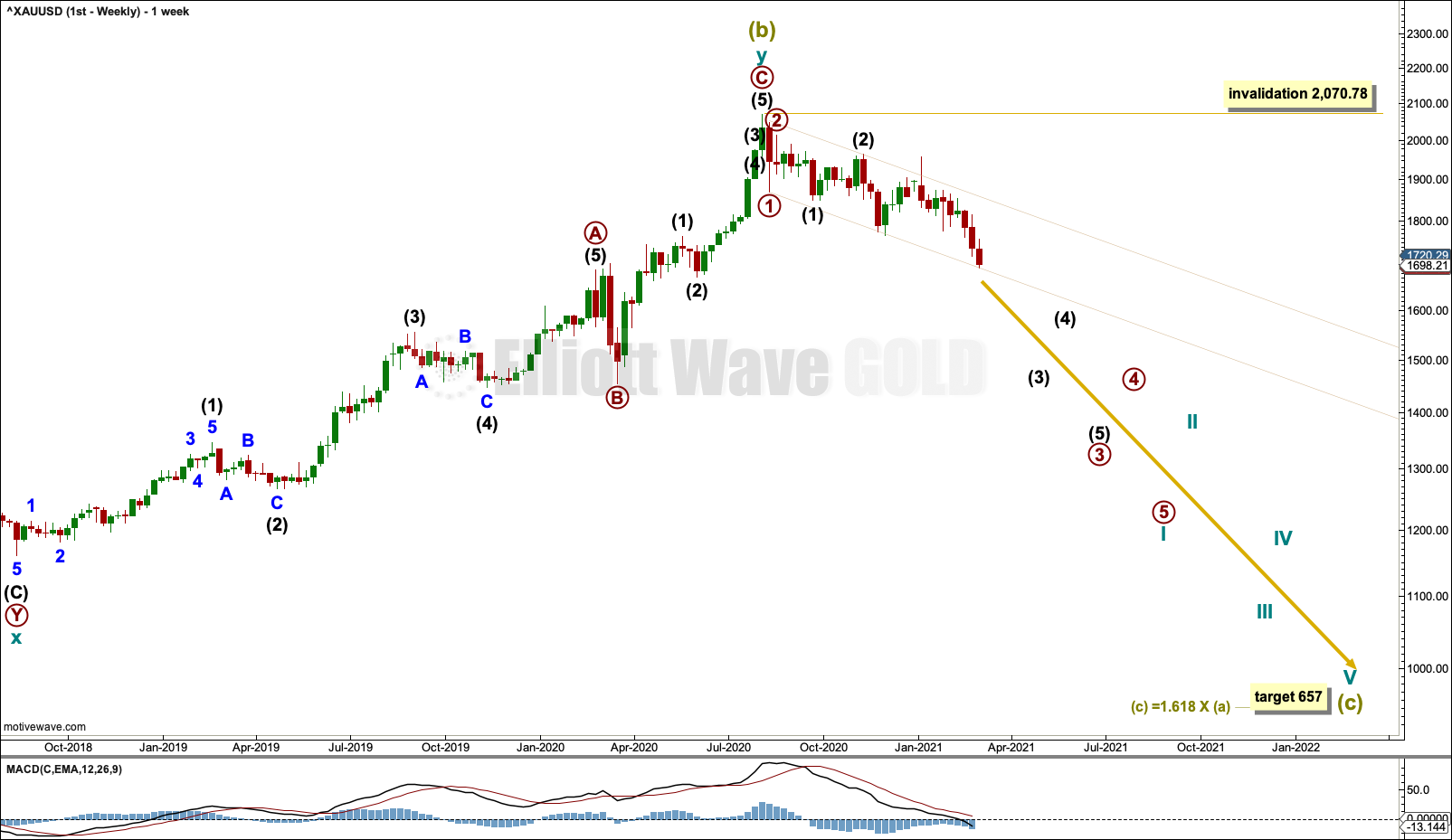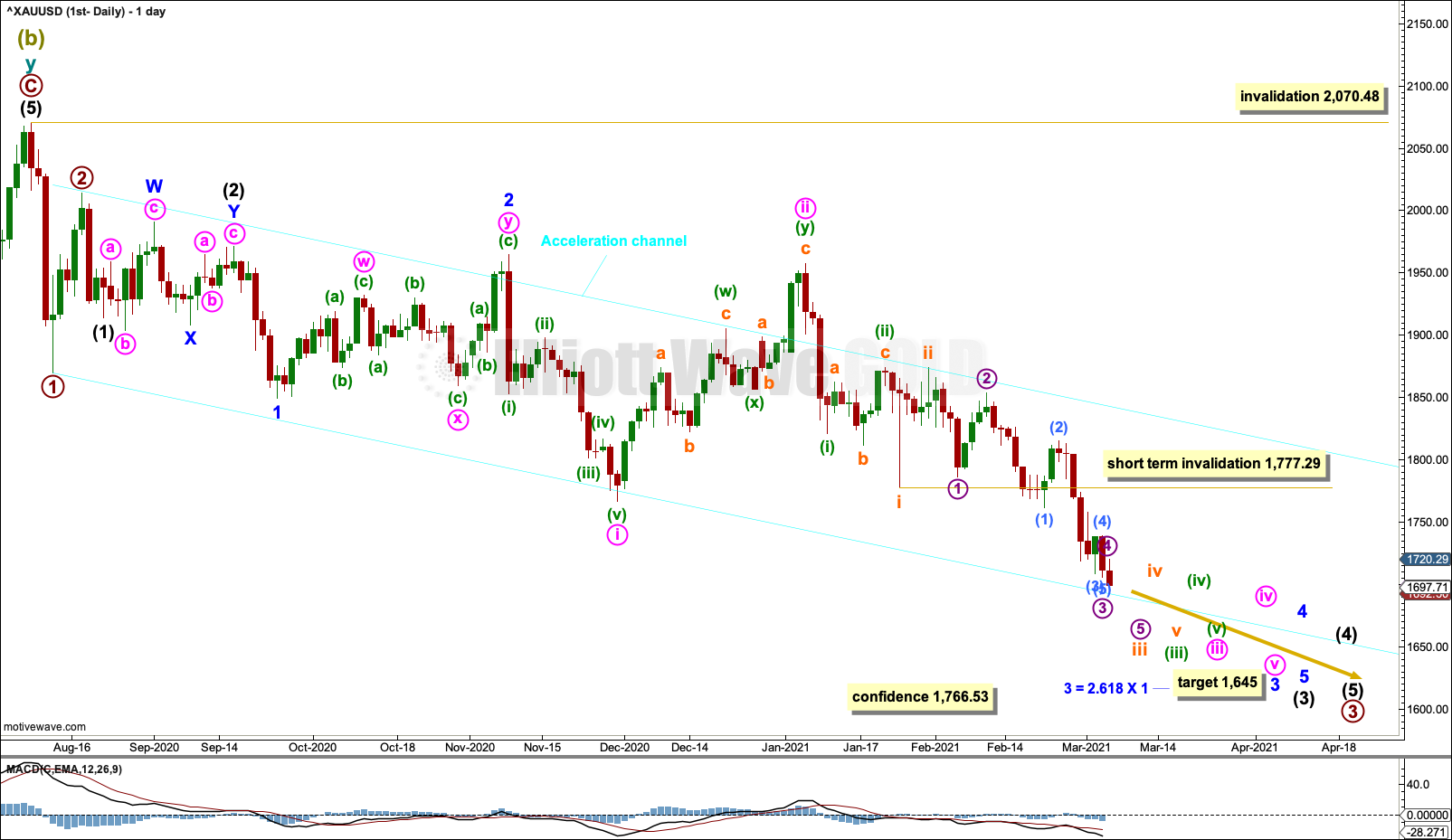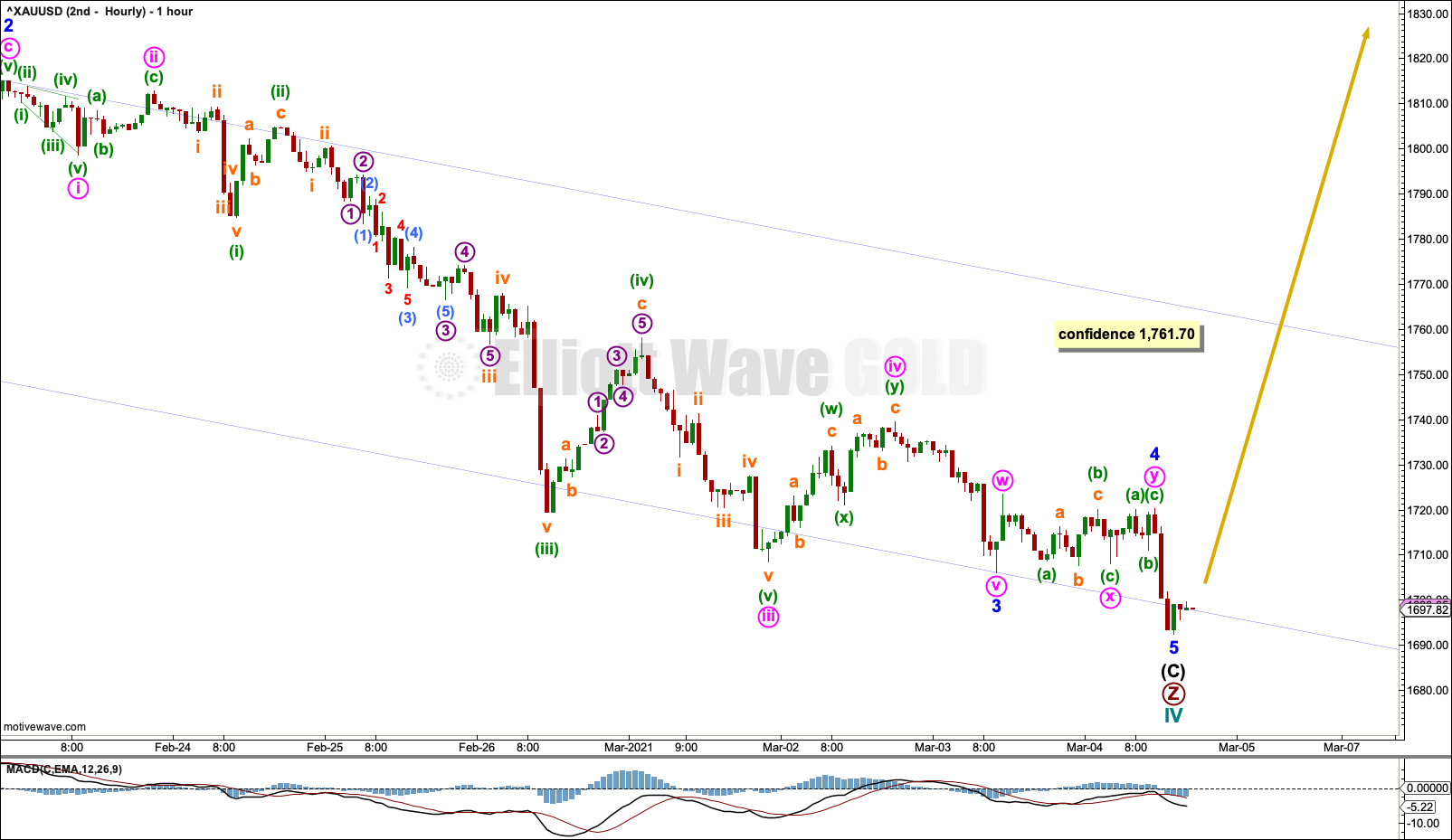GOLD: Elliott Wave and Technical Analysis | Charts – March 4, 2021
Another downwards day continues towards the next target for the first Elliott wave count.
Summary: The first wave count is bearish for the bigger picture and classic technical analysis supports this view. This wave count expects a multi-year bear market may be in its early stages to end below 1,046.
Downwards momentum may show a further increase. A short-term target is at 1,645. A long-term target is at 657.
The second wave count is bullish. A new upwards wave may now begin. The target is at 2,124.
Grand SuperCycle analysis is here.
Last analysis of monthly charts is here.
FIRST ELLIOTT WAVE COUNT
WEEKLY CHART
The bigger picture for this first Elliott wave count sees Gold as now within a bear market, in a three steps back pattern that is labelled Grand Super Cycle wave IV on monthly charts. Grand Super Cycle wave IV may be subdividing as an expanded flat pattern.
Super Cycle wave (b) within Grand Super Cycle wave IV may be a complete double zigzag. This wave count expects Super Cycle wave (c) to move price below the end of Super Cycle wave (a) at 1,046.27 to avoid a truncation and a very rare running flat. The target calculated expects a common Fibonacci ratio for Super Cycle wave (c).
DAILY CHART
Within a new bear market, cycle wave I may be an incomplete five wave impulse.
Cycle wave II within the new downwards trend may not move beyond the start of cycle wave I above 2,070.48.
Gold typically exhibits extended and strong fifth waves; this tendency is especially prevalent for fifth waves to end third wave impulses one degree higher. One or more of minute wave v, minor wave 5 or intermediate wave (5) may exhibit this tendency; there may be one or more selling climaxes along the way down. Minute wave iv and minor wave 4 may be relatively brief and shallow.
Draw an acceleration channel about downwards movement. Draw the first trend line from the end of primary wave 1 to the last low, then place a parallel copy on the end of primary wave 2. Keep redrawing the channel as price continues lower. When primary wave 3 is complete, then this would be drawn using Elliott’s first technique and may show where primary wave 4 may find resistance.
Subminuette wave 4 may not move into subminuette wave 1 price territory above 1,777.29.
HOURLY CHART
Micro waves 3 and 4 may both now be complete. Micro wave 5 may be over at today’s low, or it may continue lower to end subminuette wave iii.
Draw an Elliott channel about subminuette wave iii. Draw the first trend line from the end of micro wave 1 to the end of micro wave 3, then place a parallel copy on the end of micro wave 2. Micro wave 4 may have ended within this channel. Micro wave 5 may find support about the lower edge, or it may break below support and end below the channel if it is particularly strong.
SECOND ELLIOTT WAVE COUNT
WEEKLY CHART
This wave count sees the the bear market complete at the last major low for Gold on 3 December 2015.
If Gold is in a new bull market, then it should begin with a five wave structure upwards on the weekly chart.
Cycle wave I fits as a five wave impulse with reasonably proportionate corrections for primary waves 2 and 4.
Cycle wave II fits as a double flat. However, within the first flat correction labelled primary wave W, this wave count needs to ignore what looks like an obvious triangle from July to September 2016 (this can be seen labelled as a triangle on the second weekly chart on prior analysis here). This movement must be labelled as a series of overlapping first and second waves. Ignoring this triangle reduces the probability of this wave count in Elliott wave terms.
Cycle wave IV has moved lower; it may again be a complete triple zigzag. The rarity of triple zigzags reduces the probability of this wave count further.
If the third zigzag of primary wave Z continues lower, then cycle wave IV may not move into cycle wave I price territory below 1,303.51.
DAILY CHART
Cycle wave IV may be a complete triple zigzag.
Primary wave Z may again be complete.
The purpose of multiple zigzags is to deepen a correction when the first zigzag does not move price deep enough. To achieve this purpose multiple zigzags normally have a clear counter trend slope. Cycle wave IV looks normal with a clear downwards slope.
A target is recalculated for cycle wave V. If cycle wave IV continues lower, then this target must again be recalculated.
HOURLY CHART
The hourly chart focusses on the end of intermediate wave (C).
Intermediate wave (C) may again be seen as a complete five wave impulse, which means that primary wave Z and cycle wave IV may be complete. This wave count now expects a trend change.
A new high above 1,761.70 may not be a continuation of minor wave 4, as minor wave 4 may not overlap into minor wave 1 price territory. A new high above 1,761.70 would add confidence that intermediate wave (C) should be over and add confidence in a trend change.
TECHNICAL ANALYSIS
WEEKLY CHART

Click chart to enlarge. Chart courtesy of StockCharts.com.
There is a series of lower swing lows and lower swing highs from the last all time high in August 2020. ADX now indicates a downwards trend at the weekly time frame, and price has made another important new swing low.
RSI is not extreme. There is plenty of room for a downwards trend to continue.
A downwards trend should now be the dominant view until the trend reaches extreme and then a bullish candlestick reversal pattern is seen.
Last week an increase in volume and a bearish signal from On Balance Volume support the first Elliott wave count.
DAILY CHART
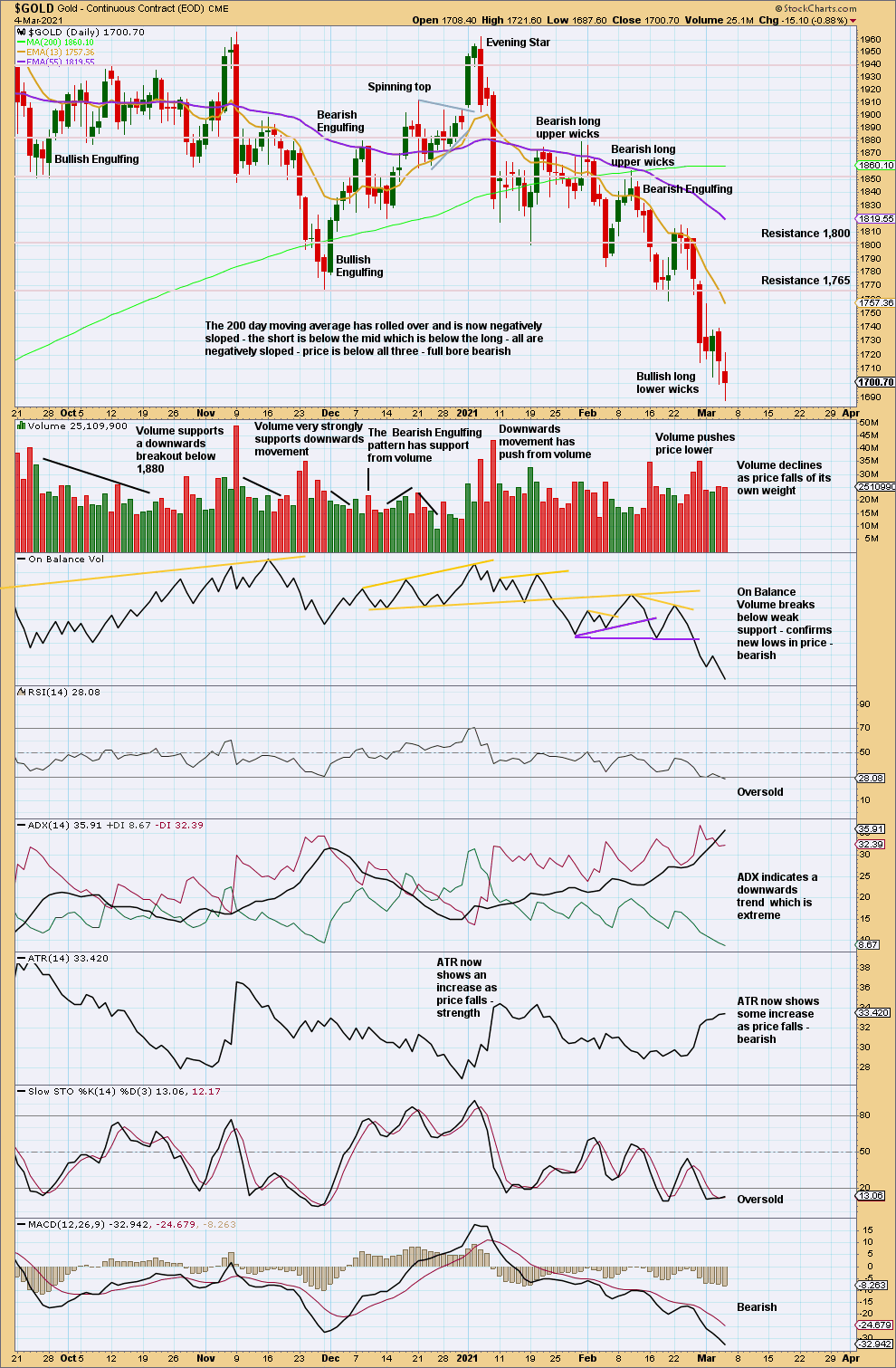
Click chart to enlarge. Chart courtesy of StockCharts.com.
RSI is just now oversold. ADX is extreme. Price can still fall further for a few days before a reversal, but these two indicators are now warning that the trend is vulnerable to a reversal.
GDX WEEKLY CHART

Click chart to enlarge. Chart courtesy of StockCharts.com.
Price is at support, so a counter trend bounce may occur here. If support is breached, then it becomes resistance. This chart is bearish.
If support at 31 is breached, then next support is about 26.3.
GDX DAILY CHART
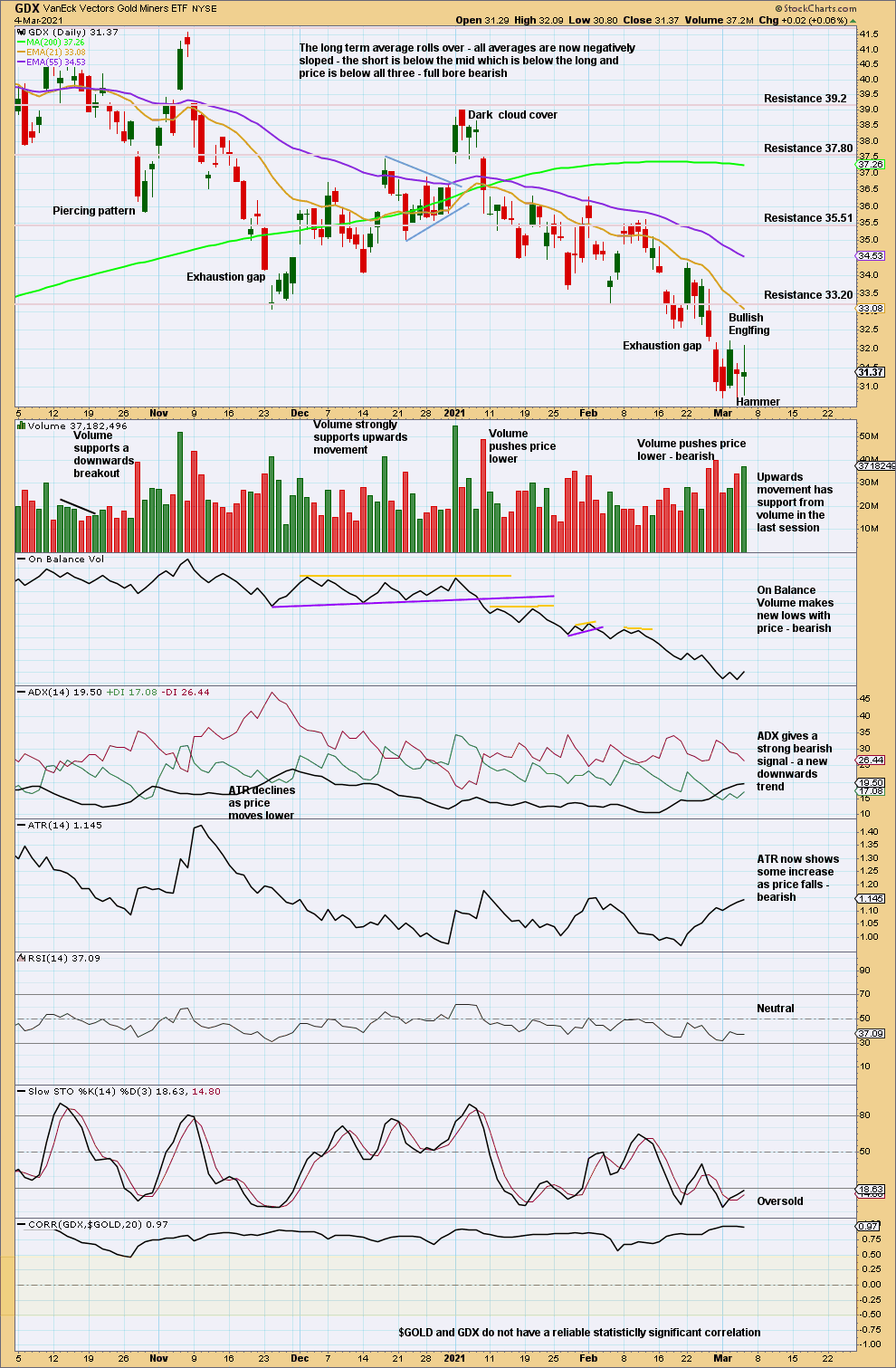
Click chart to enlarge. Chart courtesy of StockCharts.com.
A target from the measuring gap is at 30.01. This target may not be met though. Closure of the last gap indicates it is an exhaustion gap, and a Bullish Engulfing pattern suggests a trend change. Now a second bullish candlestick in a Hammer pattern reinforces this view. A counter trend bounce may occur about here.
Published @ 10:14 p.m. ET.
—
Careful risk management protects your trading account(s).
Follow my two Golden Rules:
1. Always trade with stops.
2. Risk only 1-5% of equity on any one trade.
—
New updates to this analysis are in bold.

